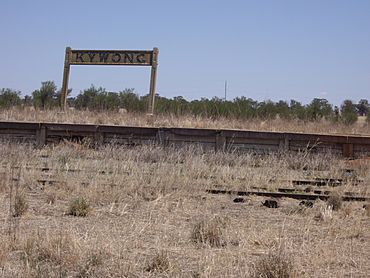Kywong, New South Wales facts for kids
Quick facts for kids KywongNew South Wales |
|
|---|---|

Kywong Railway Siding – closed 1975
|
|
| Postcode(s) | 2700 |
| Location |
|
| LGA(s) | Narrandera Shire |
| County | Mitchell |
| State electorate(s) | Cootamundra |
| Federal Division(s) | Riverina |
Kywong is a small rural area located within the Sandigo region. It is in the Riverina area of New South Wales, Australia. You can find Kywong along the Sturt Highway. It is about 520 kilometers southwest of Sydney, the state capital. It is also 64 kilometers west of Wagga Wagga.
Contents
Kywong's History and Development
Early Days: The Football Club
Kywong once had its own football team! The Kywong Football Club played in the Faithful & District Football Association. They competed in 1922 and 1923. The team then took a break from 1924 to 1931.
They returned to play from 1932 to 1935. In 1934, Kywong won the grand final against Greenvale. This exciting game was played at Boree Creek. After the win, over 200 people celebrated at a special ball in the Sandigo Hall. The club stopped playing after the 1935 season.
Kywong's Railway and Grain
Kywong was once the end point of the Kywong railway line. This railway branch connected to the larger Main Southern railway line. The Kywong line first opened in 1929. It helped transport goods and people in the area.
However, the railway line closed down in 1975. Soon after, large silos were built in Kywong. These silos were for storing grain. They were built by the Government Grain Elevators. Later, this organization became known as the Australian Wheat Board (AWB). The silos helped store grain before it was moved by train to different markets.
Local School and Silo Closure
Kywong also had its own school for local children. The Kywong Public School opened its doors in 1940. It provided education to students in the area for many years. The school eventually closed in 1985.
In 2001, the company GrainCorp owned the Kywong grain silos. They announced that the silos would be closed. This marked a change for the area's grain storage and transport.


